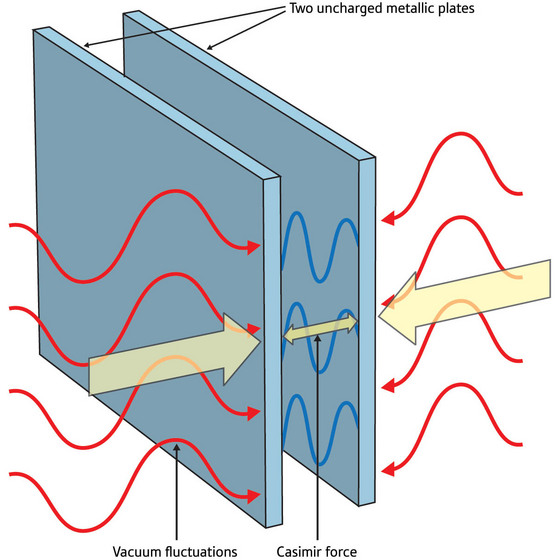Home > Press > Warming up to the Casimir force: The Casimir force between objects in a vacuum shows a complex dependence on temperature
 |
| Figure 1: Quantum electrodynamics shows that two uncharged plates in a vacuum will experience an attractive force called the Casimir force, which arises because the plates alter the fluctuations in the vacuum. Copyright © 2008 Yampol’skii and Nori |
Abstract:
When two uncharged objects are placed in a vacuum with no external fields, we wouldn't expect them to have any force between them other than gravity. Quantum electrodynamics says otherwise. It shows that tiny quantum oscillations in the vacuum will give rise to an attraction called the Casimir force (Fig. 1).
Warming up to the Casimir force: The Casimir force between objects in a vacuum shows a complex dependence on temperature
Japan | Posted on January 15th, 2009Scientists at the RIKEN Advanced Science Institute in Wako, and co-workers at the National Academy of Sciences of Ukraine (NASU), have shown for the first time that the Casimir force has a complex dependence on temperature1. They propose a related experiment that could clarify the theory around this important interaction, which has widespread applications in physics and astronomy, and could eventually be exploited in nano-sized electrical and mechanical systems.
"The Casimir force is one of the most interesting macroscopic effects of vacuum oscillations in a quantum electromagnetic field," says Franco Nori from RIKEN and the University of Michigan in the USA. "It arises because the presence of objects, especially conducting metals, alters the quantum fluctuations in the vacuum."
The Casimir force was first predicted in 1948, but has only recently been measured in the laboratory because experiments are difficult—the force is negligible except when the distance between objects is very small. More experiments are needed to understand how the force depends on temperature, an important practical consideration.
"As the temperature increases, metal objects in a vacuum experience two competing effects," explains Sergey Savel'ev from RIKEN and Loughborough University in the UK. "They lose some of their electrical conductivity, which tends to cause a decrease in the Casimir force. At the same time they are bombarded with more radiation pressure from the thermal heat waves, and this increases the Casimir force."
Nori and co-workers derived the temperature dependence for Casimir attractions between a thin film and a thick flat plate, and between a thin film and a large metal sphere. They found that the Casimir force will tend to decrease near room temperature, but can increase again at higher temperatures as the thermal radiation effects take over.
RIKEN's Valery Yampol'skii, who also works at NASU, says that "if these temperature effects were observed in an experiment, they would resolve some fundamental questions about electron relaxation in a vacuum". Such an experiment would be near-impossible with pieces of bulk metal, but could be done using extremely thin metal films.
Reference
1. Yampol'skii, V.A., Savel'ev, S., Mayselis, Z.A., Apostolov, S.S. & Nori, F. Anomalous temperature dependence of the Casimir force for thin metal films. Physical Review Letters 101, 096803 (2008).
The corresponding author for this highlight is based at the RIKEN Digital Materials Team
####
For more information, please click here
Copyright © Riken
If you have a comment, please Contact us.Issuers of news releases, not 7th Wave, Inc. or Nanotechnology Now, are solely responsible for the accuracy of the content.
| Related Links |
| Related News Press |
Physics
![]() Quantum computers simulate fundamental physics: shedding light on the building blocks of nature June 6th, 2025
Quantum computers simulate fundamental physics: shedding light on the building blocks of nature June 6th, 2025
![]() A 1960s idea inspires NBI researchers to study hitherto inaccessible quantum states June 6th, 2025
A 1960s idea inspires NBI researchers to study hitherto inaccessible quantum states June 6th, 2025
![]() Magnetism in new exotic material opens the way for robust quantum computers June 4th, 2025
Magnetism in new exotic material opens the way for robust quantum computers June 4th, 2025
Discoveries
![]() Researchers develop molecular qubits that communicate at telecom frequencies October 3rd, 2025
Researchers develop molecular qubits that communicate at telecom frequencies October 3rd, 2025
![]() Next-generation quantum communication October 3rd, 2025
Next-generation quantum communication October 3rd, 2025
![]() "Nanoreactor" cage uses visible light for catalytic and ultra-selective cross-cycloadditions October 3rd, 2025
"Nanoreactor" cage uses visible light for catalytic and ultra-selective cross-cycloadditions October 3rd, 2025
Announcements
![]() Rice membrane extracts lithium from brines with greater speed, less waste October 3rd, 2025
Rice membrane extracts lithium from brines with greater speed, less waste October 3rd, 2025
![]() Researchers develop molecular qubits that communicate at telecom frequencies October 3rd, 2025
Researchers develop molecular qubits that communicate at telecom frequencies October 3rd, 2025
![]() Next-generation quantum communication October 3rd, 2025
Next-generation quantum communication October 3rd, 2025
![]() "Nanoreactor" cage uses visible light for catalytic and ultra-selective cross-cycloadditions October 3rd, 2025
"Nanoreactor" cage uses visible light for catalytic and ultra-selective cross-cycloadditions October 3rd, 2025
Quantum nanoscience
![]() ICFO researchers overcome long-standing bottleneck in single photon detection with twisted 2D materials August 8th, 2025
ICFO researchers overcome long-standing bottleneck in single photon detection with twisted 2D materials August 8th, 2025
![]() Programmable electron-induced color router array May 14th, 2025
Programmable electron-induced color router array May 14th, 2025
|
|
||
|
|
||
| The latest news from around the world, FREE | ||
|
|
||
|
|
||
| Premium Products | ||
|
|
||
|
Only the news you want to read!
Learn More |
||
|
|
||
|
Full-service, expert consulting
Learn More |
||
|
|
||








